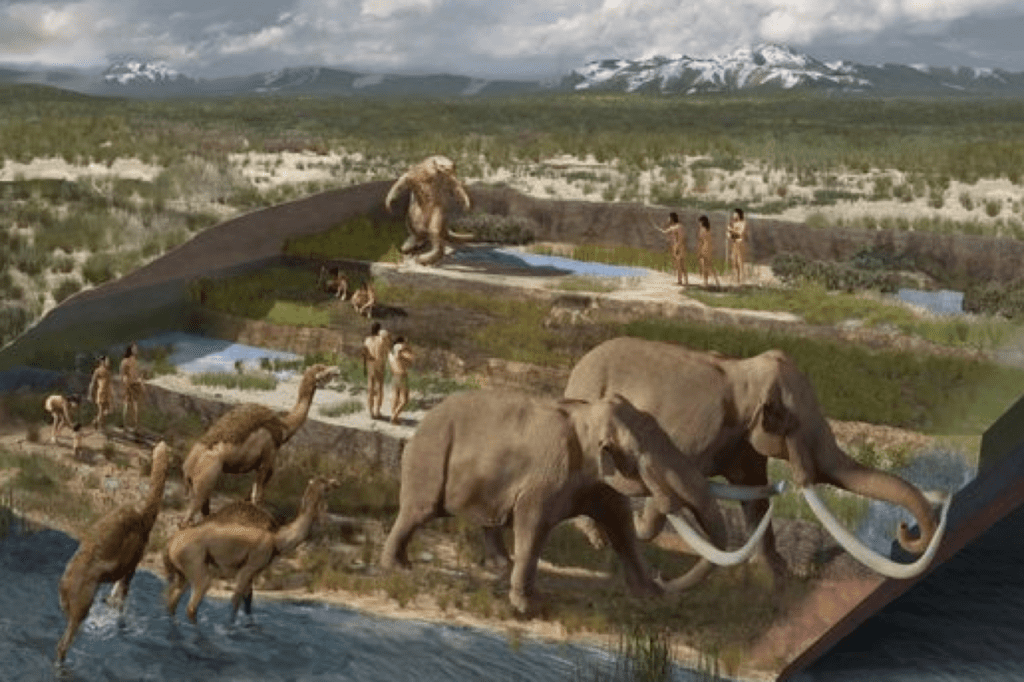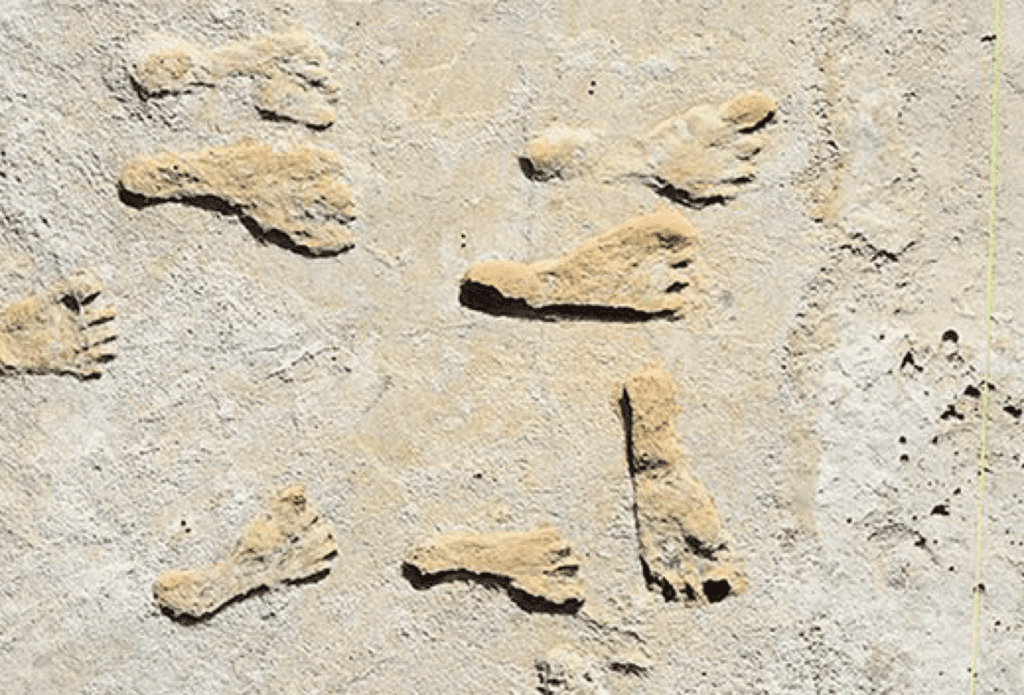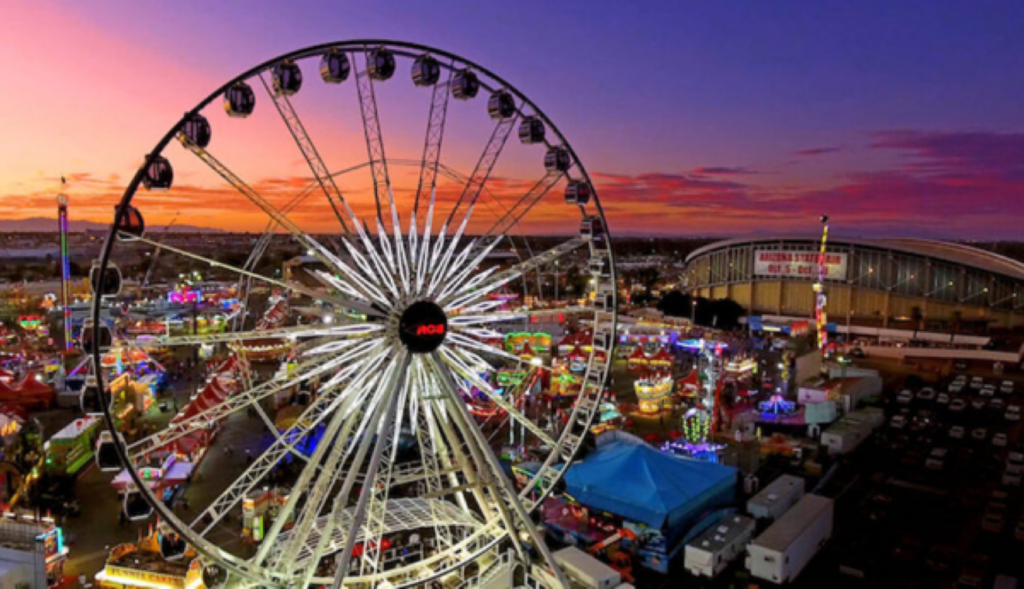Daniel Salzler No. 1117
EnviroInsight.org Four Items September 24, 2021
—————Feel Free To Pass This Along To Others——————
If your watershed is doing something you would like others to know about, or you know of something others can benefit from, let me know and I will place it in this Information newsletter.
If you want to be removed from the distribution list, please let me know.
Please note that all meetings listed are open.
Enhance your viewing by downloading the pdf file to view photos, etc. The
attached is all about improving life in the watershed. If you want to be removed from
the distribution list, please let me know. Please note that all meetings listed are open.
Enhance your viewing by downloading the attached pdf file to view photos, etc.
The attached is all about improving life in the watershed.
Read this newsletter at EnviroInsight.org
1. Ancient Footprints Yield Surprising New Clues About the First Americans. [About three hours or 200 miles east of the Arizona border, lies White Sands National Park.] Unearthed in New Mexico along what was once a lakefront, the tracks show generations living in the area thousands of years before many scientists believed

An illustration of the region that is now White Sands National Park in New Mexico, between 21,000 and 23,000 years ago. PHOTO: KAREN CARR
At the height of the last Ice Age, generations of children and teenagers ambled barefoot along a muddy lakefront in what is now New Mexico, crossing paths with mammoths, giant ground sloths and an extinct canine species known as dire wolves.
Now, some 23,000 years later, the young people’s fossilized footprints are yielding new insights into when humans first populated the Americas. Unearthed in White Sands National Park by a research team that began its work in 2016, the tracks are about 10,000 years older and about 1,600 miles farther south than any other human footprints known in America, scientists reported Thursday in the journal Science.
“It is, in my view, the first unequivocal evidence of human presence in the Americas” during the last Ice Age, Daniel Odess, chief of science and research at the U.S. National Park Service and a senior author of the report, said of the discovery. “The footprints are inarguably human.”

For decades, many scientists were convinced that humans first arrived in the Americas as recently as 13,000 years ago, reaching the continent after crossing an ice-free land bridge from Asia or by sea along the Pacific coast on the journey from humanity’s African homeland. Others argued that they arrived about 16,000 years ago, or even as much as 30,000 years ago. There simply wasn’t enough evidence in the fossil record to settle the debate.
In all, a research team led by scientists from Bournem14versity in Poole, England, discovered 61 human trackways preserved in seven layers of silt, clay and sand.
Under most circumstances, fossilized footprints are impossible to date precisely. But these were interleaved with sediments containing seeds of aquatic plants that once flourished along the lake. Radiocarbon dating of the plants showed that the footprints were 21,000 years to 23,000 years old.
The footprints represent 10 to 15 individuals and were laid down over a period of 2,000 years, mostly by children and adolescents, the scientists said. No one knows what drew the people to the spot. So far, there is no sign of campfires, tools or other artifacts.
There is little difference between modern feet and the ancient feet that made the footprints, the scientists found. “They are very normal feet,” said Matthew Bennett, a specialist in ancient footprints at Bournemouth and the leader of the research team. “The toes are nicely defined.”
In addition to giving clues about the people who made them, the footprints hint at their behavior, showing, for example, whether the people were running, carrying a heavy load or even hunting. “They’re preserving evidence of really compelling narratives about what might be going on at this time and place in prehistory,” said Dr. Hatala.
In earlier work published in 2018, the scientists described an undated set of fossilized human tracks at the White Sands site that they believe were made by people stalking a giant sloth. The tracks overlapped those of the sloth, suggesting a pursuit. “We will never see humans interacting with giant sloths, but the footprints are telling us the sloths were scared of humans and the humans were confident,” said Sally Reynolds, a paleontologist at Bournemouth and a member of the research team.
The scientists also uncovered what they believe to be the footprints of a prehistoric woman who traveled for almost a mile with a toddler, sometimes carrying the child and sometimes making the young one walk by her side. It is the longest fossilized human trackway ever discovered, according to their research, which was published in 2018 in the journal Quaternary Science Reviews.
We have found layer upon layer upon layer of human footprints, each layer taking us more deeply into the past,” Dr. Reynolds said. “It is pushing back human occupation of the Americas to before the Ice Age. People are having to revise their ideas of the first peopling of the Americas.” Read the entire story at Wall Street Journal, September 24, 2021.
2. Blue whales are the largest animals ever known to have lived on Earth. These
magnificent marine mammals rule the

oceans at up to 100 feet (30 meters) long
and upwards of 200 tons (181 metric tons).
Their tongues alone can weigh as much as
an elephant. Their hearts, as large as an
automobile. Source: National Geographic.
3. 2021 West Nile Presence Across Arizona. With Arizona’s monsoon being one of the wettest for a very long time, the number of cases reported across Arizona has gone up significantly. [ WNV is transmitted to humans by the bite on an infected mosquito, however less than 1 percent of all mosquitoes are infected. Approximately 20 percent of people infected with West Nile Virus will feel symptoms. Most people who experience symptoms will have:
Fever Headache Body aches Nausea Vomiting
Sometimes swollen lymph glands or a skin rash on the chest, stomach and back. A small percentage of people who are infected with WNV will experience severe symptoms such as meningitis, encephalitis, paralysis and even death. Persons over the age of 50 are generally at a higher risk for severe symptoms. More information can be found at: http://www.cdc.gov/ncidod/dvbid/westnile/index.htm or by calling 888-246-2675 ]
By county, the number of cases, confirmed and suspected are:
Apache ……. 1 confirmed, 3 suspected La Paz……. 0 confirmed, 0 suspected
Cochise……. 0 confirmed, 0 suspected Maricopa…144 confirmed, 601 suspected
Coconino …. 0 confirmed, 9 suspected Mohave ……. 1 confirmed, 5 suspected
Gila ………. 0 confirmed, 4 suspected Navajo……. 0 confirmed, 5 suspected
Graham…… 0 confirmed, 2 suspected Pima……… 4 confirmed, 23 suspected
Greenlee….. 0 confirmed, 0 suspected Pinal…… …23 confirmed, 25 suspected
Santa Cruz.. 0 confirmed, 2 suspected Yavapai…… 0 confirmed, 5 suspected
Yuma……. 0 confirmed, 1 suspected
Fatalities ……………. 10 Source: ADHS.gov 9/27/21, Editor
4. 2021 Arizona State Fair Guide
When: Oct. 1-30.
Where: 1826 W. McDowell Road, Phoenix.
Admission: $12, $10 for age 55 and older and ages 5-13 years old, free for age 4 and younger.
The Arizona Exposition and State Fair is returning to Phoenix for the first time in two years in October.

Thrilling rides, fried foods and livestock competitions will take over the fairgrounds for the annual fair. The Arizona State Fair has been a staple event held annually in the fall at the current site in Phoenix for 115 years. Now that is a tradition! This year’s fair will look very similar to the annual event that Valley residents are familiar with. However, there is one major change that might impact the fair’s attendance this year. Officials have announced that there will be no major concerts.
Here is a guide to the 2021 Arizona State Fair so you know before you go.
What are the dates of the Arizona State Fair in 2021?
The fair kicks off Friday, Oct. 1, and will close on Saturday, Oct. 30.
What are the hours of operations of the Arizona State Fair?
The fair is closed on Mondays and Tuesdays.
Wednesday through Sunday hours are as follows:
Noon-9 p.m. Wednesdays 11 a.m.-10 p.m. Saturdays
Noon-9 p.m. Thursdays 11 a.m.-9 p.m. Sundays
Noon-10 p.m. Fridays
Where is the Arizona State Fair?
There was some discussion that this year’s fair may move location for the first time in 115 years. However organizers scrapped the possibility and the 2021 Arizona State Fair will stay put at the fairgrounds located at 1826 W. McDowell Road, Phoenix. Major cross streets are 19th Avenue and McDowell Road.
What are ticket prices at the Arizona State Fair?
Admission can be purchased online and at the gate. Officials encourage those attending to avoid the lines and purchase online. Admission prices are as follows:
Adults (14-54 years old): $12
Seniors (55 and older): $10
Children (5-13): $10
Infants (4 and younger): Free
Virtual tickets for rides and games can also be purchased ahead of time on an app. FunPass (in the Apple Store and at Google Play) requires users to register and enable location services on their phones before they buy tickets that can be scanned at rides and game booths. A little work ahead of time, makes the process simple while at the fair.
Are masks required to be worn at the fair?
The Arizona State Fair does not require face coverings. The Centers for Disease Control and Prevention recommends that everyone wear masks indoors where COVID-19 transmission is high, which includes Maricopa County, regardless of vaccination status. The CDC also recommends to continue to social distance and wash your hands.
Where should we park?
The fair offers two designated parking lots and a VIP parking section. VIP parking is located in the North Lot and can be reserved online for $25 per car.
The entrance to the North Lot is at 19th Avenue and Monte Vista Road. Parking costs $12.
The entrance to the West Lot is on Encanto Boulevard, between 19th and 20th avenues. Parking costs $8 and requires walking down to Monte Vista Road to enter the fairgrounds.
Public transportation to the Arizona State Fair
For those who plan to take public transportation or will walk to the fair, there are several options for entering the fairgrounds from the street:
Near the northeast corner of 19th Avenue and McDowell Road.
Near the southeast corner of 19th Avenue and Monte Vista Road.
It is important to note that the entrance at the northwest corner of 17th Avenue and McDowell Road is closed this year.
What rides are at the 2021 Arizona State Fair?
The Arizona State Fair will have 58 rides and attractions in 2021 for guests to enjoy. Some favorites will be returning, including the haunted mansion, mini bumper cars and Crazy Coaster rollercoaster.
In addition, the iconic La Grande XL Ferris wheel and the Skyride will be returning. The following is a list of rides that are more fast-paced to try this year:
Cliff Hanger, where riders lie on their stomachs and fly through the air.
Crazy Coaster, a wild mouse ride with a twist.
Disk’O, a spinning platform that glides on a curved track as riders stay seated facing out.
Tilt-A-Whirl, the carnival staple with riders sitting in egg-like compartments. Zero Gravity, a wheel that spins as riders, facing inward, are pushed against the walls.
Who is performing in concert this year at the fair?
As previously mentioned, there will be no major concerts held at this year’s Arizona State Fair.
What shows are being held at the Arizona State Fair?
The events calendar includes Figure 8 racing, monster trucks and rodeos. For the full schedule, visit https://azstatefair.com/calendar.
These shows will take place at the outdoors Grandstand, which is in the northwest region of the fairgrounds.
Returning as an annual tradition and true to the fair’s origins, a celebration of Arizona’s agriculture will be present. There will be competitions for livestock as well as the fields of arts, sciences and horticulture. Source: azstatefair.com
Copyright EnviroInsight.org
